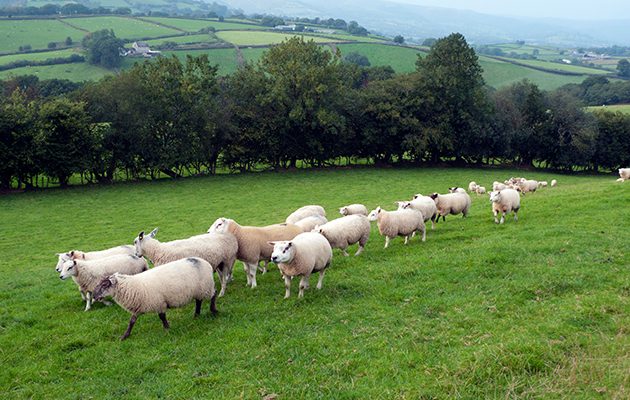The flock has been shuffled ahead of winter and shepherds prepare for the next cycle, which begins with the bangers, as Tim Field explains
Lambs are made in autumn, not spring, says Tim Field, as he explains the sheep farmer’s year.
For more on farming, read growing maize and how to reverse the environmental impact.
THE SHEEP FARMER’S YEAR
Morning mist lingers, hiding the spectrum of golden, orange, red and copper hues across the hedgerows and woodlands. No sooner do the rays break through to reveal the glowing colours than the sun starts dropping in the sky and evening draws in. We are deep into autumn and with hay cutting and the browning, parched summer pastures a bygone memory, the grass has greened up as the soil temperatures hold but are refreshed by seasonal rains. The rejuvenated grasslands provide a contrasting vivid green throughout the landscape. Broadly termed the aftermath (originally an old English farming term translated as “after-mowing”), this grass growth is a vital last bite of nutrition before winter-induced senescence limits the value of grazing lands.
In preparation for this time the shepherd has undergone a good shuffle of his stock. The noise of weaning has deafened the valleys over past weeks and crops of lamb have been sent to market. Supermarkets, restaurants and TV chefs would have us believe there is something special about spring lamb but it is bunkum. Autumn is the season to celebrate British lamb; it has been reared and finished on fresh pasture and with lambing prevailing during spring the market is saturated with excellent product – so it’s cheap. The modern promotion of spring lamb is a savvy marketing manoeuvre by the New Zealand producers, which should be nonsense to our nation with such strong heritage in sheep farming.
With lambs thinned out, attention turns back to ewes and rams. Replacement rams have been sought at market; farmers simply looking to produce fat lambs might favour commercial traits such as growth rates
and prolificacy whereas those breeding pedigree sheep will be more selective over the right bloodlines, details of specific traits and colouration.
Meanwhile, the ewes head to good pasture for three weeks of bliss before the ram joins and the sheep farmer’s year starts all over again. Since the weaning at the start of autumn, the ewes have undergone a diet review, a careful pedicure to avoid lameness, teeth and teats have been checked and dags trimmed.
The tough hill sheep are brought in from outlying ground; the moors, hills, downs and fells begin to fall quiet as the in-bye land suddenly comes to life with bleating. Wherever the sheep are, three weeks on good pasture is a critical step prior to tupping as a skinny ewe is less likely to ovulate successfully. However, while good nutrition is important, too much fat can also impede conception so a middle ground has to be found. With the fleece bulked up in readiness for winter, an eye-ball over a flock doesn’t give a true indication of fat covering so the shepherd needs to get hands on; a good feel of the backbone and short ribs is translated into a condition score, from 1 (emaciated) to 5 (obese). With the flock closer to home, corralling, handling and then micro-managing becomes infinitely easier.
The tupping season is a colourful time in more ways than one, as the ram (or “tup”) gets dressed up with brightly coloured raddle before being introduced to the ewes. Raddle is a dye applied to the tup’s brisket, either strapped on as a crayon or slopped on as oily paint, strategically placed to rub on the rump of the ewe as the tup serves his purpose. There are many derivations on this technique but following the principle that a ewe’s oestrus cycle averages 17 days and the ram is introduced for at least two cycles (34 days), with at least one colour change, the shepherd knows which ewes have been covered, the rough timing of lambing and the success (or otherwise) of the ram. With anything up to 100 ewes to serve, a mature ram will have his work cut out so he too will be brought up to top condition.
The gestation period of a ewe averages 147 days and with our aim to start lambing the commercial flock on 1 April, it makes “date night” easy to remember. Count back the days and the ram conveniently joins the ewes on Guy Fawkes Night – recalled by the old adage “in with a bang and out like fools”. As a rule of thumb, the pregnant ewes will remain on the good pasture for the next six weeks to maintain good condition so that the fertilised eggs can develop successfully.
The farm manager often reminds us that “lambs are made in autumn and not spring”, so the shepherd’s eye for detail at this time is critical to a successful sheep enterprise. During a season of loud bangs and vibrant colours, great attention is paid to dressing up the tups and preening the ewes as forthcoming lamb yields are determined.
Follow Tim and Agricology @agricology





